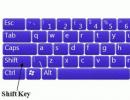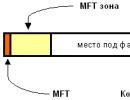How to press a sign on the keyboard. Computer keyboard: layout, keys, symbols and signs
Often, when first getting acquainted with a personal computer, the user has a question about what characters are on the keyboard and how to enter them. Within the framework of this article, each group of keys will be described in detail, indicating its purpose. A method for entering non-standard characters using ASCII codes will also be outlined. This material is of greatest interest to those who work with a text editor, such as Microsoft Word or another similar application (OpenOffice Writer).
Functional set
Let's start with There are 12 of them on the keyboard. They are located in the top row. Their purpose depends on the open application at the current time. Usually a hint is displayed at the bottom of the screen, and these are the most frequently performed operations in this program (for example, creating a directory in Norton Commander is “F7”).

Keys and register
A special group of keys are keys. They control the operation mode of another part of the keyboard. The first one is "Caps Lock". It changes the case of letters. By default, lowercase characters are entered. If we press this key once, then when we press the keys, they will appear. This is the simplest and most convenient way to put characters on the keyboard with different case. The second key is "Num Lock". It is used to toggle the numeric keypad. When it is turned off, it can be used for navigation. But when turned on, it works like a regular calculator. The last key in this group is “Scroll Lock”. It is used in table processors. When it is inactive, it moves through the cells, and when it is turned on, the sheet scrolls.
Control
Separately, it is worth considering the control keys. First of all, these are arrows. They move the cursor one position left, right, up and down. There is also page navigation: “PgUp” (page up) and “PgDn” (page down). To go to the beginning of the line use “Home”, to the end - “End”. The control keys include “Shift”, “Alt” and “Ctrl”. Their combination switches the keyboard layout (this depends on the operating system settings).
While holding “Shift”, the case of the entered characters changes and it becomes possible to enter auxiliary characters. For example, let's find out how to type characters from this set on the keyboard. Let's enter "%". To do this, hold down “Shift” and “5”. The set of auxiliary characters depends on the active keyboard layout at the current time. That is, some characters are available in the English layout, and others are available in the Russian layout.
We pay attention to the symbols that are on the keyboard. Deleting a character on the left is "Backspace" and on the right is "Del". “Enter” - goes to a new line. Another special key is “Tab”. In a table, it provides a transition to the next cell, and at the end adds a new line. For text, pressing it causes an “increased” indentation between characters to appear. And in the file manager, pressing it leads to a transition to another panel.

Basic set
The main set depends on the active layout at the current time. It can be Russian or English. Switching between them is carried out using the combinations “Alt” + “Shift” on the left or “Ctrl” + “Shift”. The selected combination is determined in the operating system settings. You can find out the active combination by selection. That is, click the first of them and look at the state of the language bar (located in the lower right corner of the screen). If the language has changed, it means that this is the combination we need (for example, from “En” to “Ru” or vice versa). The first one is installed by default.
The alphabetic characters on the keyboard are located in its central part and are divided into three rows. The more often a symbol is used, the closer it is to the center, the less often it is used, the further it is from it. That is, the letters are distributed not alphabetically, but according to At first, it is difficult to get used to this principle of organizing the distribution of characters, but the more you work, the more you get used to it and understand that it is really convenient. One more nuance that needs to be taken into account. For short-term switching between capital and uppercase letters, it is better to use “Shift”, and for long-term typing - “Caps Lock”.

Numeric keypad
Another required component of such input devices is a numeric keypad. It is located on the right side of it. It has two modes of operation: input and navigation. In the first case, characters are typed on the keyboard (these are numbers and basic mathematical operations). This is convenient when working with large A; in the second option, the keys for moving the cursor and page navigation are duplicated. That is, arrows for moving the marker, “PgUp”, “PgDn”, “Home” and “End” - all this is present here.
Switching between them is done using the “Num Lock” key. When it is turned off (the LED is inactive), navigation works, and when turned on, digital dialing works. If necessary, you can set the desired operating mode after booting the personal computer into the BIOS (this is best done by advanced users, since beginners may have problems with this operation).

Punctuation marks
Punctuation marks on the keyboard are concentrated mostly near the right “Shift” key. This is a period and a comma. Also in the English version of the layout, the remaining symbols (colon, question and exclamation marks) are located on the main numeric keypad, which is located immediately below the function keys. To enter them, briefly hold down “Shift” and together with it the corresponding button.
About what doesn't exist
But what about the characters that are not on the keyboard? Is there any way to get them? The answer to this question is yes. There are two ways to type such characters. The first of these involves using the Word text editor. After launching it, go to the “Insert” toolbar and select “Symbol” there. In the list that opens, select “Others”. Then a special input window will open. Here, using the navigation keys, find the desired symbol and press “Enter”.
Additional characters on the keyboard can be typed in another way - using ASCII codes. This works in all Windows applications - a major plus. The downside is that it uses a lot of code that you need to remember. First, we find out the digital code of the sign we need on the official website of Microsoft Corporation or in any other source where there is a corresponding table, and remember it. Then we go to the application we need.
Be sure to turn on “Num Lock”, hold down “Alt” and on the numeric keypad on the right, sequentially type the code found in the previous step. At the end, you need to release “Alt” and after that the desired symbol must appear. For example, to enter “ ”, use the combination “Alt” + “9829”. This is convenient to use for non-standard

Design of text messages in chat or pages on social networks. After all, it is much more convenient to remember a non-standard record than a regular one. And this decision just contributes to this.
Results
Within the framework of this material, all the characters on the keyboard that exist today were described. The purpose of all keys is indicated and practical examples of operation are given. It also shows a working methodology that allows you to go beyond the usual set of characters using ASCII codes. All this together will help the novice user to thoroughly understand the operation of the keyboard and understand the basic principles of the functioning of a personal computer.
Every modern user sooner or later faces a task called “typing”. This is an operation that does not require any special skills. Just press the buttons on the keyboard. Sometimes you have to put a variety of signs and symbols in electronic documents. They can be punctuation marks or constants of exact sciences. How to print them? You can find some of the characters on the keyboard. Below we will tell you everything about how to put certain symbols in electronic documents. Let's look at the processes using the example of working in Windows and Word.
Dialing methods
How to put up signs? Only a portion of the special characters are located on the keyboard. And there are usually no problems with their set.
Possible ways to type special characters include:
- using buttons with corresponding signs;
- working with keyboard shortcuts;
- use of "Unicode";
- use of Alt codes;
- work with the “Copy” and “Paste” keyboard shortcuts.
You can also insert symbols on your computer:
- through working with the "Insert formula" option;
- by inserting from the "Windows Symbol Table";
- using Paste Special in a text editor.
Which option should I use? It all depends on personal preference. Therefore, we will further focus on the most popular methods for solving the problem.
Keypad buttons
On the keyboard, characters are located in different places. Typically, special characters can be found to the right and left of or above the main alphabet. We are talking about buttons with numbers.
When typing characters using keys on the keyboard, either the Russian or English layout is used. For example, to put a period, you can:
- press the button located to the left of the right “Shift” while dialing “Russian”;
- switch to the English layout and click on the letter "U".
As a rule, keyboard characters typed in this way are limited to slashes, brackets and punctuation symbols. It's not difficult to pick them up.

Keyboard shortcuts
The second method for solving the problem is to work with keyboard shortcuts on the keyboard panel. This arrangement is reminiscent of the previously presented principle.
When using it you need:
- Find a button with a particular symbol on the keyboard.
- Switch the keyboard layout to Russian or English. It depends on what kind of sign you need to put.
- Click on Shift.
- Click on the desired key.
To make it clear what we are talking about, let’s look at an illustrative example. How to type a question mark on the keyboard?
To do this you will need:
- Find the key with the number 7 on the keyboard. It is located above the main alphabet.
- Make sure that the Russian layout is currently activated on the keyboard panel.
- Press "Shift" and the previously mentioned key.
Fast, simple and very convenient. Unfortunately, not all characters can be found on the keyboard. To insert a variety of special characters, Alt codes and Unicode are usually used.
Working with the Copy and Paste commands
Before studying such techniques, it is worth paying attention to one more. We are talking about using the "Copy" and "Paste" options. They can be activated using the keyboard.
To print this or that special character, the user will need:
- Find a ready-made text with the desired sign.
- Select the corresponding symbol. For example, using the "Shift" key and the arrow keys on the keyboard.
- Press Ctrl + C. This option is responsible for copying the symbol to the PC clipboard.
- Place the typing cursor in the desired location.
- Press "Control" + M (Russian). This combination is responsible for pasting from the clipboard.
This approach is not very common in practice. To use it, you have to look for ready-made texts with symbols. It's not as simple as it seems.

"Alt" codes
How to put characters on the keyboard? The next solution is to use alt codes. This solution allows you to quickly type special characters on your computer.
Instructions for working with alt codes look like this:
- Activate Num Lock mode on your computer. If the option is active, the corresponding indicator light on the keyboard will light up.
- Place the cursor where the symbol is printed.
- Hold down the Alt key. Usually there are two of them on the keyboard. Any will do.
- Type the alt code on the number pad (on the right side of the keyboard). It can be clarified in a special reference book or using the "Windows Symbol Table".
- Release the buttons.
After this, one or another symbol will appear in the text document. Thus, characters are typed on the keyboard very quickly.
To put the infinity sign in Word using the described method, you need to press the Alt key and type the code 8734 on the keyboard. This will lead to printing the symbol ∞. To print a heart ( ) you need to hold down Alt + 3.

Unicode to the rescue
Characters on the keyboard can be printed using Unicode. This is another simple way to type special characters.
To use it, the user will have to:
Find out the "Unicode" of a particular character. You can find it in the "Windows Character Table" or in the "Special Character" section in Word.
- Write the Unicode character where it is printed.
- Press Alt + X.
After these steps, the request will be processed and the inscription will be converted into a symbol.
To understand how to type characters on the keyboard using Unicode, consider an example of printing the % character. To do this you will need:
- Dial code U+0025 (with a plus).
- Press "Alt" + Ch.
About symbol tables
Now let's find out where the paste special is located in Word and the Character Table in Windows. This will help you type characters on your keyboard.
In the first case you will need:
- Open a text editor.
- Click on the tool called "Insert". Here you can find the "Object" section - Microsoft Equation. It is responsible for printing mathematical formulas.
- Click on the "Symbol" button.
- A sign with special symbols will appear on the monitor display. Here you can find any printable character on your computer.
In the second case, you can do this:
- Open "Start".
- Go to the section "All programs" - "Standard".
- Expand the "Service" folder.
- Click on the line labeled "Symbol table...".
Beginners sometimes have a question: how to put an exclamation mark on the keyboard of a computer or laptop? Everything is extremely simple. In both cases, the keyboards are very similar, the differences are only at the level of the function keys and their location. Basic printed characters remain unchanged.
Above the three rows of letters of the Russian and English alphabets is a row with numbers. When you press these buttons normally, the corresponding number will be entered. However, if, when pressing a key, you first hold down the Shift button, then the characters that are shown in the upper left and lower right parts of the buttons will be entered. Everything will depend on the currently selected language layout - English or Russian.
So, if you look at the numbers from 1 to 0, you can immediately notice that the “1” key has an exclamation mark. Thus, to type an exclamation mark on the keyboard, hold down the Shift key (either on the left or on the right) and press one ( Shift + 1). It should be noted that the exclamation mark will be entered regardless of the current layout, since this button does not have another auxiliary character for which it is responsible for entering.
Here is a photo of a desktop computer keyboard and a laptop keyboard so you can make sure that in both cases the key you are looking for is in the same place.

If for some reason it was not possible to put an exclamation mark, then you can:
1. Copy it directly from this page - here it is “!”. Select it, right-click and select copy. Then, use the same method to paste it into the document you need.
2. Go to a search engine, for example, Yandex. There is a keyboard icon on the right side of the input field. By clicking on it, a keyboard will open at the bottom of the screen, completely replicating a real standard keyboard.

Next, we perform the actions described at the beginning of the article, namely, press the “Shift” button, and then the number key “1”. As a result, an exclamation mark will be printed in the input field. You can also copy it from there.

3. If you work in the Microsoft Word text editor, then you can type the symbol you are interested in by selecting “Insert” - “Symbol” - “Other symbols...” in the main menu.

In the dialog box that opens, you need to find the exclamation mark and click the “Insert” button, then close the window.

It wouldn’t hurt to immediately show some other symbols that are often used when typing on a computer:
Thus, we have figured out where the exclamation mark is on the keyboard, now you should not have problems finding the right key.
The period is an absolutely necessary punctuation mark when communicating with people on the Internet. If a comma can often be ignored, and the interlocutor will still understand you, then without periods it will be much more difficult to understand your thought. The good thing is that it’s not at all difficult to type. Below you will see a picture in which it is immediately clear how to place a dot on the keyboard. Everything is clear and simple.
We put a dot on the keyboard in Russian and English layouts
If you are typing in Russian (the keyboard is in Russian typing mode), then you need to press the key to the right of “ YU". It's to the left of the right button Shift. Finding it is very simple: Find the key Enter (Enter). Below it is a key Shift. To the left of the last one is the “ .
«
In the English layout (when the keyboard prints in English), the key " dot" is located to the left of the key that we used to enter a period in Russian.
 As you can see, everything is simple. To put a point, you don’t even need to hold down two keys. Or is it necessary? Let's see how to put an end to another operating system other than Windows.
As you can see, everything is simple. To put a point, you don’t even need to hold down two keys. Or is it necessary? Let's see how to put an end to another operating system other than Windows.
How to put a dot on the Apple MacOS keyboard
- To type a dot on an Apple keyboard, you need to hold down two keys and press the third. Namely - Ctrl+ Option (Alt) + YU.
- The second method does not work on all devices. You need to press Shift + 7.
 These simple steps need to be performed to display a point on the screen of your device using the keyboard. We wish you success in your further computer development!
These simple steps need to be performed to display a point on the screen of your device using the keyboard. We wish you success in your further computer development!
A vote for a post is a plus for karma! :)
Putting a comma on a regular keyboard or laptop is very easy. Another thing is where exactly in the proposal to add it so that there is no mistake.
The Word program or this little instruction will help you 90% with this, although it is best to study the punctuation completely.
To type a comma on the keyboard, you need to see which layout is enabled - Russian or English.
It depends on them where the comma will be located on the keyboard of your netbook, laptop or USB computer.
How to write a comma in the Russian keyboard layout
In a laptop and a regular keyboard with a Russian layout, the comma is in the same place, but you won’t be able to place it with one key.
To print it, hold down the Shift button - you can print it on the right or left side, there is no difference.
Then click on the button with four symbols: a question mark, a semicolon and two sticks - it is located at the bottom right side. See fig.

How to make a comma on an English keyboard
In an English-language keyboard, placing a comma is much easier; more precisely, you only need to press one key - the one where the Russian letter “B” is located.
If you often have to change the layout, I recommend using a small free application - Ruslat95.
Having launched it once, you can switch the language by pressing just one key – “Ctrl”. This is faster than the standard method - two.
By the way, there are many applications that improve text input from the keyboard, for example, a program that automatically selects the layout you need.
vsesam.org
Lesson 3. How to enter punctuation marks on the keyboard
At the request of blog visitors, I am writing news)) Many people say, “they press a period, but a comma is entered, or vice versa.”
Rule one. Remember that depending on what language you are typing in (keyboard layout) and whether you are holding down the Shift key, each key will enter different characters.
Punctuation marks in Russian
(Russian layout).
This picture (above) shows the complete keyboard with all the characters that can be entered. Let's now look at punctuation marks in the Russian layout.
Only those punctuation symbols that can be entered when typing text in Russian are displayed here. It turns out that no matter how hard we try, we won’t enter the @ sign on the Russian keyboard
I think everything is clear with the letters, to make the letter large you need to press Shift + letter (I advise you to read the lesson “Windows Keyboard Shortcuts”)
So, let's pay attention to the top row of keys. If in Russian we simply click on them, numbers will be entered, if we press the Shift key, then those punctuation marks at the top will be entered, not numbers.
Example: How to enter the punctuation mark “Comma” in Russian? To do this, we need to press the shift key and without releasing its dot (the key to the right of the letter yu), if we just click on it, we will get a dot. How to enter a number sign in Russian - No? To do this, press the shift key and without releasing its number 3. How to enter a question mark in Russian? Shift+7, -i.e. press the shift key and without releasing the number 7, and then naturally release the seven and Shift.
Punctuation in English
Everything is the same here, below is a picture with those symbols and punctuation marks that can be entered in English.
Please note that there are characters that can only be entered in Russian or only in English. Also note that on the English layout, a comma is entered by pressing the Russian letter B, and a dot on Y. If you press SHIFT, you will enter a greater than sign or a less than sign
Tim-Plus.ru
How to put an apostrophe on the keyboard
When working with text documents, it is often necessary to place the top comma, which is more correctly called an apostrophe, in the right place. It is most often used when writing English words, but there are exceptions. In this topic, we will consider all the options for how to quickly place an apostrophe on the keyboard of a laptop or computer, using hotkey combinations and built-in character tables in Windows and Microsoft Office.
The classic way to enter an apostrophe
Unfortunately, this method is demanding on the keyboard layout. Therefore, before adding the top comma, make sure that the keyboard layout of your laptop or computer is switched to English. Afterwards, you just need to press the key with the letter “E” and the top comma will be inserted into the place you need.
The advantage of the method is speed. The downside is constant control over the keyboard layout.
Unconventional input method
This method of placing a comma on top is less popular and is used only by advanced users. Although there is no difficulty in it, you just need to remember the hotkey combination “Alt+0146”.
Please note: this combination involves the number keys from the right numeric block of the keyboard. The top number row is not suitable for this purpose.
The advantage of the method is that it is not demanding on the keyboard layout. The downside is a more complex combination of shortcut keys.
We use the symbol table built into Windows
The third option for placing the upper comma is to refer to the operating system symbol table. There are several ways to open it.
- Use the search bar in the Start menu.
- Use the key combination “Windows + R” to launch the “Run” command interpreter and use the “charmap” command.
Having launched the table, select the apostrophe sign, click on “Select”, and then “Copy”.
In this case, the upper comma character will be copied to the clipboard. All that remains is to insert it into the right place.
There is no advantage of the method in relation to previous input methods. The downside is the low input speed and the mandatory presence of a mouse.
Using the symbol table in Microsoft Office
The fourth option to place a comma at the top of a word is to use the same symbol table built into the Microsoft Office package. We will show an example in Word version 2007. If you have a different version of this application, there may be some minor interface differences.
Open the application and go to the “Insert” tab. Next, simply select the “Symbol” item. To open the entire table, click on the “Other symbols” link.
Please note: if you need to put an upper comma when working with Excel, then the procedure is identical.
In the table that opens, select the apostrophe symbol and click insert.
The advantages and disadvantages are the same as the previous method.





